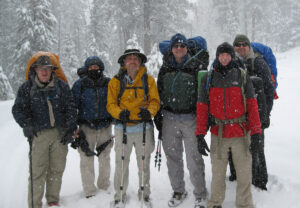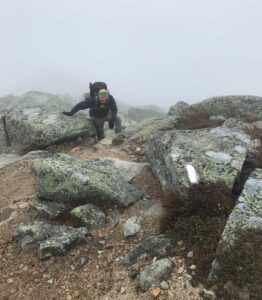
Image courtesy of Chuck Haller
For Chuck Haller and a few of his West Virginia college buddies, hiking the Appalachian Trail began as nothing more than “practice.” During a camping trip, the four of them thought it would be fun to hike the Grand Canyon rim to rim before they turned 50, and but they needed to work on their trail legs.
So in October of 2007, they did their first Appalachian Trail hike together.
The friends had done some backpacking in college and enjoyed the outdoors “before life took over,” Haller says, referring to marriages and kids and careers. They met at Caledonia State Park in Pennsylvania — relatively centrally located to the group who were living in places such as Richmond, Virginia; Elkins, West Virginia; and Pittsburgh.
That first trip, “We took way too much stuff, didn’t understand the terrain, and didn’t understand how to hike effectively,” he says. But they finished it, and almost immediately, they said, “Let’s do that again.”
So a few months later, they connected again at Caledonia and went the other direction on the AT. Before long, these long weekends on the AT became a regular occurrence, and they set in motion a plan to section hike the entire trail.

Image courtesy of Chuck Haller
Soon they had 300 miles under their belts, and the goal became doing a total of about 100 miles annually between Maine and Georgia.
“We became seasoned hikers,” he says. “By that time we had figured out weight distribution, what to carry, what not to carry.”
Their distances and sections are meticulously catalogued in a spreadsheet — they can easily reference every hike they’ve ever done. As of summer 2023, they had 1,639 miles checked off, with 555 to go. That’s based on a 2,194 mile Appalachian Trail.
The iconic trail, which was formally completed in 1937 despite frequently shifting routes during its long history, isn’t an easy trail to hike. Roughly 165,000 white blazes that mark the longest hiker-only trail in the United States, winding its way along old growth forests, ancient mountains, and the most beautiful East Coast national parks.
Haller jokes that after “practicing” on the AT, the Grand Canyon was a comparably much easier hike.
The group’s long hiking weekends, often starting on Thursday and wrapping up Sundays, typically knock out about 30 miles of trail each time.
With a little digging, it wasn’t long before they learned that the trail through Maine and New Hampshire is particularly tough. So in the mid-2010s, a few years into their section-hiking adventure, they chose to tackle those areas. After all, even though most of the group was closing in on retirement age, they were still young enough to be able to handle those sections. The more the years dragged on, the less confident they would be in that regard.
“A good hike for us, we try to hit 10 to 12 miles a day,” Haller says. “We get going to New Hampshire, and we’ve heard this is hard, so we figure 8 to 10 is about right. We were more in the 5- to 7-mile range.
“We met thru-hikers, and they say the most they can do in New Hampshire is like 10 on a hard day. Back in Pennsylvania, they said they were doing so much more. New Hampshire was very eye-opening. …
“So when you do New Hampshire, just probably cut it in half or 60 percent of what you’re used to doing,” he says.

Image courtesy of Chuck Haller
That’s also one of the more dangerous areas to be hiking. Haller says that climbing Mount Lafayette in New Hampshire took almost three times longer than anticipated. Even when they approached that section with the best intentions of making up the time on a subsequent day, one fellow traveller feigned encouragement and said, “Sure, if you don’t die first.”
Makes you wonder if it was a joke or not.
“The Mount Lafayette journey, it’s miserable, it’s raining, and we get to the top and it is fogged in and it’s at dusk,” Haller says. “We had no water left, so we dug a little trough in the side of the mountain where the water was coming off the rocks. We collected the water and had our little pump to fill up our canteens.”
They then made their way below the tree line and camped. The “flat” ground was close to a 20-degree angle. The ground was almost too rooty for tents. They were too tired to cook anything that night or the following morning. Cold food and granola bars were all they could manage.
“We just … we were done,” Haller says of the experience.
“We got off the mountain, and then the next year we picked up the parts we missed,” he says. “It was one of those times: We lived, and it was a tough moment, but it was also a good memory.”
Haller is 63 and retired now, living in Tellico Village, Tennessee. He hikes a lot with his wife and stays active playing pickleball. He and his crew (which has since added his daughter’s father-in-law) have covered most of the middle regions of the AT.
For example, they’ve done the northern Great Smoky Mountains continuously through New York, and the southern part of the Smokies is knocked out. A three-day stretch from Clingmans Dome to Davenport Gap is yet to be conquered.
He says they have everywhere south of Fontana Lake in North Carolina left to do, as well as of most of Vermont, Connecticut, and Massachusetts, as well as large chunks of Maine.
Their goal is to have the trail completed by the time they turn 70.

Chuck Haller climbs the slopes of Mount Katahdin in Maine. (Image courtesy of Chuck Haller)
And, unlike Mount Lafayette, most sections usher in less nail-biting memories.
Haller says New Hampshire overall is very pretty — “It’s my favorite state,” he says — and McAfee Knob outside of Roanoke, Virginia, stands out as an amazing spot. In New York, there are some spots where you can see New York City in the distance, which Haller loved.
And then there’s the Smokies, which are essentially right in his backyard.
“I just did the Smokies about a month ago, this lower part of the Smokies, and we made a wrong turn and ended up at a fire tower. It was a miserable day,” he says. “You can climb up in the fire tower, so I climbed up about halfway or a little more, and from there, the view was just gorgeous. Even though it was a horrible day, the rain had sort of passed through, and you could see the low-lying clouds just settling in the valley and the mountaintops sticking out. …
“There are moments like that that are just totally unexpected that you find.”
For a decade and a half, this has been their lives. Prior to retirement, this was a chance to break for a few days from the stress of their careers. And they met lots of people on the trail and had a chance to learn something about themselves in the process (start out small, Haller advises).
The miles can be a challenge, and like anything else, finding a way to make something meaningful will bring people back to it year after year. For Haller, the Appalachian Trail is enjoyable.
“As a section hiker, we don’t have the mystique or the prestige of doing it all in one fell swoop, but it has definitely worked out well for us this way, and definitely works out at age 63.”
Ryan Tipps is Managing Editor for ActionHub. He lives along the Blue Ridge Mountains, is an avid hiker, backpacker and trail runner and has been a part of the wilderness search and rescue community since 2005.

 Your Privacy Choices
Your Privacy Choices
 The
The